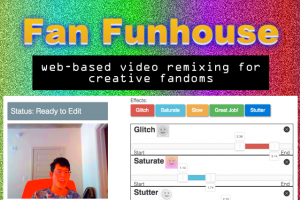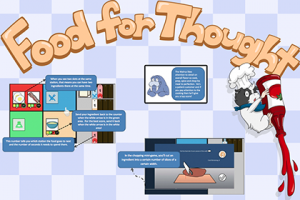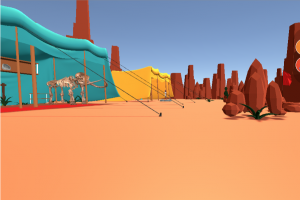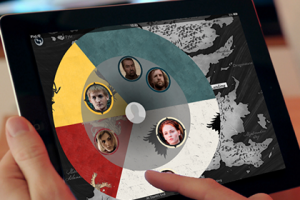|
PostArt is a simple, easy-to-use tool for older adults with Mild Cognitive Impairment to create digital postcards for family and friends. In addition to creating, they can share and view postcards created by other members. The goal of PostArt is to facilitate self-expression and social engagement in older adults with MCI in the Cognitive Empowerment Program. |
Fan Funhouse is a browser-based video remixing application that allows users to edit webcam videos using a palette of effects inspired by a pop culture franchise. The increasing prevalence of user-generated media production in apps and on the web has coincided with pop culture brands, ranging from The Powerpuff Girls to Peanuts, providing fans with opportunities to quickly create and share personalized "fan media" in their web browsers.  |
The FIDO Sensors team is creating wearable technology to allow working dogs to communicate. Assistance dogs can tell their owners with hearing impairments what sounds they have heard; guide dogs can tell their owners if there is something in their path that must be avoided. We will be demonstrating a variety of wearable sensors designed for dogs to activate.  |
In 2014, Flextronics (now Flex) came to Georgia Tech with an interest in integrating and testing devices in our authentic home environment (The Aware Home). They were at a stage in their development of the Wink Hub where they needed a home environment to test ranges and reliability, as well as show clients how their products would integrate into a home environment. The Wink Hub is now available as a Do It Yourself solutions for the connected home, enabling transfer of messages between in-home devices and the Wink cloud. |
Flow MedtechLab: Currently, 4.4 million Americans have been diagnosed with atrial fibrillation (AF), in which the heart beats in an irregular rhythmic pattern. That number is estimated to reach 12-16 million by the year 2050. Patients with atrial fibrillation have over a fivefold increase in the chance of stroke. Due to complications from the current standard of care, anticoagulants (i.e. blood thinning drugs), to treat resulting thromboembolism (i.e. clotting) from AF, alternative treatments are actively being sought out to decrease complications and risk of stroke.  |
Over the past 2 years, we have performed experiments to understand what activities within a video game context result in cognitive gains (and which do not). From these findings, we have developed a custom cognitive game called "Food for Thought.  |
FossilVR is a novel virtual environment that grounds the skill of making inferences in an authentic context: a paleontological fossil dig. |
Fossil VR is a virtual reality tool that allows students to accompany a paleontologist into the field to find fossils and make observations and inferences about their findings.  |
|
Much of the research on educational technology (e.g., MOOCs and adaptive learning systems) has been driven by the capabilities of technology instead of the pedagogy and cognition of learners. Our research takes the opposite approach. A review of the literature on educational technology and instructional methods for teaching STEM courses was used to identify the strengths of technology in education. These findings are being used to develop educational technology and provide heuristics and guidelines for developing effective STEM courses that optimally support learning.  |
A CAPTCHA is a challenge-response test used on the Internet to prevent bots from accessing web services that are designed for humans. We are investigating Automatic Game based CAPTCHA Generation (AGCG), in which an AI system generates games that, when played, distinguish between humans and bots. The game based CAPTCHA takes advantage of not only the bots' difficulty performing pattern/object recognition, but also their lack of commonsense knowledge. Thus it is more secure but remains easy and fun for humans, compared to traditional visual based CAPTCHAs. |
Games with a purpose (GWAPs) have proven to be effective solutions to solving difficult problems, labeling data, and collecting commonsense knowledge. Unlike traditional games, GWAPs must balance between acquiring accurate solutions or data and maintaining player engagement. However, when it comes to designing GWAPs, the effects of different game mechanics on accuracy and engagement are not well understood. We have conducted two studies to understand the way different choices of game mechanics and their affect on player behavior. |
The complexity of television shows has been increasing. In order to follow a story, viewers might be expected to stay abreast of more plot threads, remember more characters, and retain information introduced in earlier seasons. Media technology has made the job easier by allowing viewers to review in various ways; they may replay a scene or entire episodes, they may visit an online forum for fans, or they may play a video game that is related to that story. Game of Game of Thrones is a video game design intended to explore how a video game could enhance the viewing of a television series. |
|
The transition from novel to television creates the issue of compressing the story into episodes limited by time and budgets. HBO 's translation of Game of Thrones is a rich tapestry of characters and narratives; however, the viewer can lack backstory, geographic awareness, and an understanding of character relationships. This second-screen companion app orients viewers to the world of Westeros by mapping families throughout episodes. Greater character understanding is achieved by the mapping of character relationships, both during characters present in each scene or within the episode.  |
We have a multi-year project exploring how game performance and player behavior can be used to perform scientifically valid cognitive, personality, skill, and behavioral measures. This project involves hypothesizing about how game mechanics, levels, situations etc. could assess aspects of a player that are currently measured via validated traditional tests/activities/interviews, designing games around these hypotheses, and running user studies. Another aspect of this work is exploring how theming, feedback, game type influence the assessment validity and the players' desire to play the game. |


